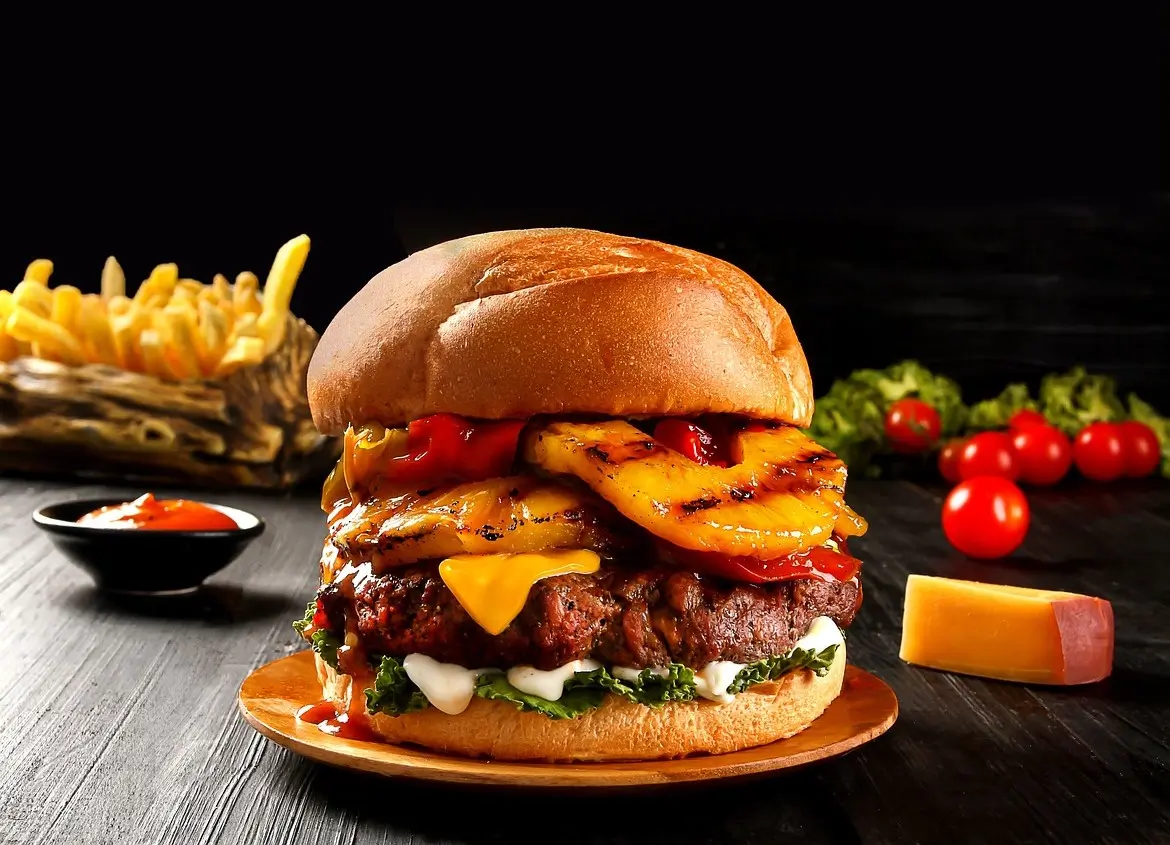Restaurant Food Cost Management
Table of Contents
Restaurant food cost management is crucial for success in the bustling world of restaurants and food service businesses. There are many expenses involved in buying, preparing, and serving food. It’s essential to control costs while maintaining quality and profitability. This guide will explore strategies to help you navigate food cost management effectively, ensuring your business survives and thrives in the competitive culinary landscape.
1. Tracking Food Prices: Keeping Up with Fluctuations
Staying informed about changes in ingredient prices is essential. For instance, let’s say that the price of beef has increased due to a shortage. Tracking food prices in this scenario would allow you to make intelligent decisions about menu options. You could include cost-effective alternatives like chicken or vegetarian dishes without sacrificing taste or quality. Think of your menu as a symphony, with each ingredient playing a vital role in harmony with your budget.
2. Conducting Inventory: Keeping Tabs on Stock
Regular inventory checks are not just good practice; they are vital for efficient food cost management. Just like a savvy investor monitors their stocks, keeping track of inventory helps you monitor usage and prevents waste. Remember, every item in your pantry affects your bottom line, and every efficient inventory check is a step towards a healthier financial status for your business.
3. Joining a Purchasing Group: Strength in Numbers
In the procurement world, unity is not just a concept; it’s power. Joining a purchasing group is like having a secret weapon in your arsenal. It allows you to leverage the buying power of similar businesses, giving you access to better prices and terms from suppliers. It’s a way to save money and a lifeline for independent restaurants facing food cost challenges, potentially transforming your business’s financial health.
4. Embrace the Prep Work: From Raw to Ready
Preparing food from scratch saves money compared to buying pre-made items and allows creative expression in the kitchen. Think of it as a canvas for your culinary artistry, where every chop and sauté contributes to your financial success. Your role in this process is crucial, as you are the artist shaping the future of your business. With the right guidance and tools, this can be a manageable and rewarding process.
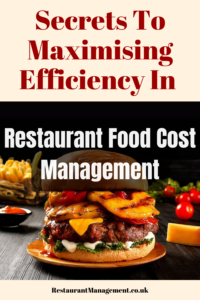
5. Reviewing Produce Specifications: Quality Matters
Precision is critical when it comes to production. By reviewing specifications, you can ensure you’re getting the quality you need without overspending. Remember, quality over quantity elevates your dishes from good to gourmet.
6. Managing Waste: Making Every Ingredient Count
Waste is the enemy of profitability in the kitchen. Implementing waste reduction practices and monitoring portion sizes is crucial. Every scrap has potential, so use leftovers creatively to save money.
7. Portion Control: Finding the Right Balance
Portion Control: Finding the Right Balance. Consistent portion sizes help control costs and ensure customer satisfaction. It’s about finding the sweet spot—neither too much nor too little—to satisfy both palate and profit margins. Think of it as a culinary dance, where each plate perfectly balances taste and cost.
8. Pricing Your Menu Items: Balancing Value and Costs
Pricing Your Menu Items: Balancing Value and Costs. Pricing menu items requires a delicate balance. Ensure prices cover ingredient costs and labour while still providing value to customers. Regularly review and update prices to reflect changes in fees or market conditions. This strategy is crucial because it ensures that your menu remains competitive while also covering your costs, which is essential for maintaining profitability.
9. Sales Forecasting: Predicting Demand
Sales forecasting plays a pivotal role in restaurant business planning by allowing you to predict future demand accurately. This means you can plan your inventory and staffing levels more effectively, which can help you optimise your resources and stay ahead of the competition. Sales forecasting is like looking into a crystal ball for your business, allowing you to make strategic decisions and plan for success.
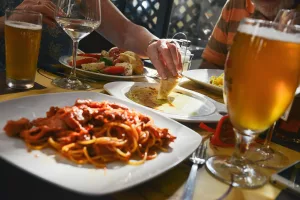
Purchasing and Inventory Management: From Sourcing to Stock
Procurement and inventory management are crucial for success. Source ingredients from reputable suppliers at competitive prices and track inventory efficiently. Each ingredient plays a role in your culinary story of success.
Kitchen and Cooking Procedures: Efficiency is Key
Efficient kitchen procedures are not just a set of rules; they are the heartbeat of your operation. And the key to their success? Proper staff training. Ensuring your team is equipped with the right skills and knowledge minimises waste and streamlines operations. It’s about turning chaos into a culinary symphony, and it all starts with your staff.
Waste Reduction and Cost Analysis: Turning Waste into Savings
Regular waste audits and cost analysis help identify inefficiencies. For example, let’s say you notice that a particular dish is consistently being returned uneaten. This could indicate that the portion size is too large, leading to unnecessary waste. By adjusting the portion size, you can reduce waste and save money. Every piece of information gained contributes to sustainable profitability. It’s about turning scraps into savings for your business.
Implementing these strategies isn’t just about cutting costs but maximising profitability while maintaining quality. It’s about creating a sustainable business model that can weather the storms of the ever-changing food service industry. Adaptability and innovation are essential in this landscape. By embracing these principles of food cost management, you can turn your culinary venture into a success story.
How To Control Food Costs In Restaurants: 7 Insider Tips On Causes And Solutions
Step-by-Step Action Plan for Managing Food Cost
1. Analyse Current Food Cost: Begin by reviewing your current food cost percentage. Calculate this by dividing your total food costs by your total food sales and multiplying by 100 to give you an overview of where you stand and how much room there is for improvement.
2. Set a Target Food Cost Percentage: Determine a realistic target food cost percentage based on industry standards and your business goals to serve as a benchmark for your efforts to manage food costs effectively.
3. Track inventory Regularly: Implement a system for regular inventory checks, which should ideally be done on a weekly or bi-weekly basis to monitor usage, identify trends, and spot any discrepancies that may indicate waste or theft.
4. Monitor Purchasing Practices: Keep a close eye on purchasing practices to ensure you get the best value for your money. Consider joining a purchasing group to leverage collective buying power and negotiate better prices with suppliers.
5. Optimise Menu Pricing: Review your menu prices to ensure they reflect the cost of ingredients, labour, and overheads while still providing value to customers. Regularly update prices to account for changes in fees or market conditions.
6. Embrace Efficient Kitchen Procedures: Implement efficient kitchen procedures to minimise waste and maximise productivity. Provide proper training to staff on food preparation and handling techniques to ensure consistency and reduce errors.
7. Practice Portion Control: Implement portion control measures to ensure consistent serving sizes and minimise over-portioning. Train staff on portioning techniques and monitor portion sizes regularly to prevent unnecessary waste.
8. Minimise Food Waste: Implement waste reduction practices throughout your operation. Encourage creative use of leftovers, monitor production levels to avoid over-preparing, and donate surplus food to local charities or shelters.
9. Analyse and Adjust: Regularly analyse food cost data to identify areas for improvement. Conduct cost analyses, waste audits, and sales forecasts to pinpoint inefficiencies and make data-driven decisions to optimise operations.
10. Communicate and Motivate: Keep your staff informed and motivated to contribute to food cost management efforts. Communicate your goals, provide ongoing training and feedback, and recognise and reward staff for contributing to cost-saving initiatives.
11. Review and Refine: Continuously review and refine your food cost management strategies based on performance metrics and feedback. Stay adaptable and open to change, and be willing to adjust your approach as needed to achieve your target food cost percentage.
By following this step-by-step action plan, restaurant managers can effectively manage food costs, optimise operations, and maximise profitability in their establishments.
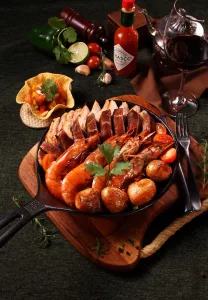
Case study: Guide to Conducting Weekly Inventory
Calculate Starting Inventory: Begin by determining the value of your food inventory at the start of the week. In this case, let’s say you start with £4000 worth of food at the beginning of the week.
Record Purchases: Throughout the week, keep track of all food purchases made for the restaurant. If you purchased £6000 worth of food during the week, make sure to record this amount.
Calculate Ending Inventory: At the end of the week, take a physical count of the remaining food inventory, giving you the ending inventory value.
Calculate Cost of Goods Sold (COGS): Determine the cost of goods sold during the week by subtracting the ending inventory value from the sum of the starting inventory and purchases.
- Formula: COGS = (Starting Inventory + Purchases) – Ending Inventory
- Calculate Sales: Determine the total sales made during the week. If your sales were £ 15,000, record this amount.
- Calculate Food Cost Percentage: Calculate the food cost percentage by dividing the cost of goods sold by the total sales and multiplying by 100.
Formula: Food Cost Percentage = (COGS / Total Sales) * 100
Analyse Food Cost Percentage: Review the food cost percentage to assess if it aligns with your target. In this case, if your food cost percentage is 30%, it means your food costs account for 30% of your total sales.
Identify Discrepancies: Compare the actual food cost percentage with the target food cost percentage. Detect any inconsistencies and conduct a thorough examination of the underlying reasons.
Adjust Inventory Practices: Make any necessary adjustments to your inventory management practices based on your analysis, which could involve tightening purchasing controls, reducing waste, or optimising portion sizes.
Plan for the Next Week: Use the insights gained from the weekly inventory to plan for the upcoming week. Adjust ordering quantities, menu pricing, or operational procedures to improve food cost management and maximise profitability.
By following these steps to conduct a weekly inventory and analyse food cost performance, you can make informed decisions to optimise inventory management and ensure financial success for your restaurant.
Related Articles:
Best Restaurant Inventory Management System
How To Manage Food Cost In Restaurants: Weekly Inventory
To determine the amount of food left at the closing inventory, you need to subtract the cost of goods sold (COGS) from the sum of the starting inventory and purchases.
For example, given:
Starting Inventory (Beginning of the week) = £4000
Purchases during the week = £6000
Sales (Weekly)= £15000
Food Cost Percentage = 30%
First, let’s calculate the COGS:
COGS = (Starting Inventory + Purchases) – Ending Inventory
Ending Inventory = (Starting Inventory + Purchases) – COGS
We already know the COGS is calculated as follows:
COGS = Total Sales * (Food Cost Percentage / 100)
COGS = £15000 * (30 / 100) = £4500
Now, let’s calculate the ending inventory:
Ending Inventory = (Starting Inventory + Purchases) – COGS
Ending Inventory = (£4000 + £6000) – £4500
Ending Inventory = £10000 – £4500
Ending Inventory = £5500
So, £5500 worth of food is left at the closing inventory. If you have done your job well during the week, that’s the figure you should have at the end of the week. Plus or minus more than 5% of this figure means you have an issue on your hand and should investigate it.
The Ultimate Guide To Mastering Restaurant Kitchen Inventory
Food Cost Responsibilities of Restaurant Managers:
Restaurant managers are responsible for various aspects of food cost management, including:
- Monitoring and controlling inventory levels to minimise waste and ensure optimal stock levels.
- Developing and maintaining relationships with suppliers to negotiate favourable pricing and terms.
- Implementing portion control measures to ensure consistent serving sizes and minimise over-portioning.
- Analysing sales data and food cost reports to identify trends, discrepancies, and areas for improvement.
- Training your staff on the proper food handling procedures is crucial to minimise waste and ensure food quality.
- Developing and updating menu pricing strategies to reflect changes in food costs and market conditions.
- To improve profitability, implement cost-saving initiatives, such as menu engineering and waste reduction programs.
Free Restaurant Food Costs Management App:
There are many free apps that can help restaurant managers manage their food costs. These apps are specifically designed to assist restaurants in keeping track of their food expenses and ensuring that they stay within budget. Some examples of such apps include:
- Zip Inventory: You can track inventory levels, manage recipes, and analyse food costs.
- SimpleOrder: Helps you streamline inventory management, track supplier orders, and analyse food costs.
- Kitchen CUT: Offers inventory management, recipe costing, and menu engineering tools to optimise food costs.
- Restaurant Manager: Provides inventory tracking, recipe management, and food cost analysis features.
- CostBrain: You can track inventory, analyse recipe costs, and generate food cost reports.
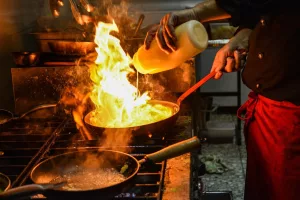
FAQs (Frequently Asked Questions)
How often should I conduct inventory checks?
It’s best to conduct inventory checks regularly, ideally weekly or bi-weekly. However, the frequency may vary depending on the size and nature of your establishment.
What practical ways to minimise food waste in a restaurant setting?
Minimising food waste can be achieved by creatively using leftovers, implementing portion control measures, and donating surplus food to local charities or shelters.
How can I ensure that my menu prices accurately reflect my food costs and overheads?
Conducting thorough cost analyses, considering ingredient costs, labour, utilities, and other overhead expenses, is essential. Regularly reviewing and updating menu prices to reflect cost changes or market conditions is crucial for maintaining profitability.
What are the foundations of restaurant food cost management?
The foundations of restaurant management food cost include:
- Understanding food cost calculations, including calculating food cost percentage and cost of goods sold (COGS).
- Implementing effective inventory management practices, such as regular inventory checks and proper storage techniques.
- Developing standardised recipes with accurate ingredient measurements to ensure consistency and minimise waste.
- Establishing portion control measures to control serving sizes and reduce over-portioning.
- Examining information on sales and costs of food to recognise patterns, monitor progress, and use insights obtained from data to make informed choices.
- Building relationships with suppliers to negotiate favourable pricing and terms.
- We need to provide our staff with the necessary training on appropriate food handling procedures, techniques for controlling the portions, and strategies for saving costs.
- To improve profitability and sustainability, implement cost-saving strategies, such as menu engineering, waste reduction programs, and purchasing optimisations.

